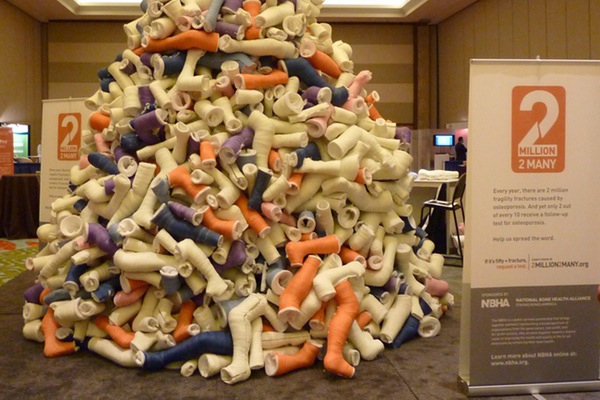
Half of people who break a hip have already had at least one broken bone. Less than 1 in 5 who break their hip are on treatment for osteoporosis. Approximately 80 percent of people treated in clinics or hospitals for a fracture are not subsequently screened for osteoporosis or for their risk of falls.
A national initiative, 2Million2Many, is named based on the 2 million bone breaks that occur due to osteoporosis every year in the US. As part of the initiative, a mountain of casts was produced that represents the 5500 fractures that occur every day. The visual impact of this “mountain” that is a massive 12 feet by 12 feet structure is striking. Standing next to this exhibit gives you a feeling of magnitude of this problem.
The trouble is the number of fractures is expected to swell to three million by the year 2025. The cost to our healthcare system is estimated to be $25 billion per year.
This is just not a US problem it is a global problem. Worldwide up to 1 in 2 women and 1 in 5 men over 50 years of age will suffer a fracture due to osteoporosis.
These statistics are discouraging for those of us trying to increase awareness and education about osteoporosis. The goal is not to have a fracture at all. But if you have one, stop any more from occurring. Therefore, the focus of the 2012 World Osteoporosis Day is “Stop at one. Make your first break your last -Capture the Fracture.”
Our healthcare system is literally fractured. No system is in place to capture high-risk individuals and intervene to reduce the risk of a first or another fracture. Care of fracture patients has been characterized as the “Bermuda Triangle” into which the fracture patient disappears.
Kaiser’s Southern California system has a model program that decreased their hip fracture rate by over one-third. Their “Healthy Bones Program” identifies and targets every adult with a broken bone or osteoporosis by bone density. These high-risk individuals are evaluated and treated resulting in reduction of broken bones.
Nationally and worldwide, groups are trying to incorporate similar methods to reduce the risk of another fracture. The National Bone Health Alliance is trying to secure funding to do a demonstration project. The goal is to decrease the number of fractures by 20% by year 2020. This reduction and more is achievable with increased awareness and education of you, healthcare practitioners, hospital systems, and insurance carriers.
Image: 4BoneHealth
